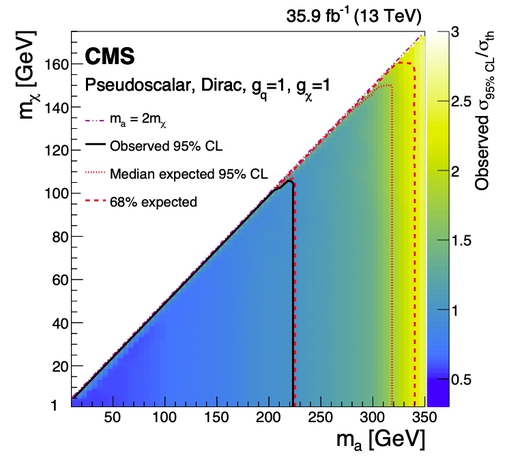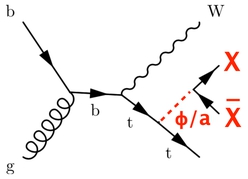DM Searches with Top
Searches for Dark Matter with Top Quarks
Compact Muon Solenoid Experiment
Searches for Dark Matter with Top Quarks
Search for Dark Matter Production in Top Quark Events
The DESY Exotics group performs searches for dark matter particles produced in association with a top quark pair at Run-2.
Dark Matter that interacts with the visible sector in particular via a pseudoscalar mediator is an appealing scenario, naturally avoiding the limits from Dark Matter direct detection searches while generating a rich LHC phenomenology and yielding a possible explanation for the FERMI gamma ray Galactic Centre Excess.
The process we therefore investigate is tt production associated with the production of a Dark Matter pseudoscalar mediator, or scalar mediator, that couples to Dark Matter particles (resonantly or non-resonantly) that leave the detector undetected. Therefore a potential dark matter signal would be observed as an excess of events compared to the predicted background at high missing transverse momentum.
Our group analysed data corresponding to an integrated luminosity of 35.9 fb−1 recorded by the CMS detector at the LHC analysing dilpton final states [1]. The distribution of missing transverse momentum is shown in Figure 2. No significant excess over the Standard Model expectation is observed.

Figure 2: Missing transverse momentum distribution in the dileptonic channel. The solid red line shows the expectation for a signal with ma = 100 GeV and mχ = 1 GeV. The last bin contains the overflow events. The lower panel shows the ratio of the observed to the fitted distribution (points), and the ratio of the background expectation before the fit to the fitted distribution (dashed magenta line). The vertical bars indicate the statistical uncertainty on the data. The horizontal bars on the rightmost plot indicate the bin width. The uncertainty bands in both panels include the statistical and systematic uncertainties on the total background.

Figure 3: The exclusion limits at 95% CL on the signal strength μ = σ/σth computed as a function of the mediator and dark matter mass, assuming a pseudoscalar mediator. The mediator couplings are assumed to be gq = gχ = 1. The dashed magenta lines represent the 68% probability interval around the expected limit. The observed limit contour is almost coincident with the boundary of the 68% probability interval.
The results are interpreted using simplified models of dark matter production via spin-0 mediators that couple to dark matter particles and to standard model quarks, providing constraints on the coupling strength between the mediator and the quarks. An example of such limits is shown as a function of ma and mχ in Fig. 3. These are the most stringent collider limits to date for scalar mediators, and the most stringent for pseudoscalar mediators at low masses.
Today:
Currently within the DESY-CMS group we extend our previous search in dilepton final states with additional missing transverse energy to the full Run-2 dataset. In addition we started to extend the search to single top quark final states. An example Feynman graph is shown in Figure 4.
Future:
We will optimize our searches with machine learning techniques which will increase our sensitivity to find a signal of Dark Matter particles associated with top quarks and separate them from Standard Model top quark pair production background.
In addition we intend to explore how top quark reconstruction can be improved in such final states, because both neutrinos coming from top quark decays and Dark Matter particles not belonging to the top quark decay products will leave the detector undetected. It is a special challenge to find out what amount of missing transverse energy has to be accounted to the neutrinos and therefore to the top quark, and what amount is accounted to Dark Matter particles. We have done studies using "gradient boosting" machine learning techniques and want them to explore further.
These topics are ideal for a bachelor or master thesis.
Reference:
[1]: CMS Collaboration, Search for dark matter particles produced in association with a top quark pair at √s = 13 TeV, Phys. Rev. Lett. 122, 011803 (2019), arXiv:1807.06522 [hep-ex], CMS-EXO-17-014.

